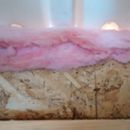Should I fix these attic vent baffles?
My builder recently added the attic vent baffles to my house under construction. I looked at them and realized that when I had read about attic vent baffles on Green Building Advisor, these don’t follow the recommendations and I’m looking for opinions on how much impact this will have and if I should have them make a modification.
Right now there is no ceiling drywall or insulation up there, so it would be “easy” to make a change, but in a week we hope to have ceiling drywall and insulation blown, so then it would become too late.
I attached a picture of what they did to this post. Our wall is 12″ thick so there is a top plate on top of that and then OSB comes up vertically from the outside edge of the top plate for 7.5″.
A couple inches above that are the roof trusses, and they stapled the vent baffles to that which are thin foam and go diagonal down past the OSB.
So that leaves a gap between the vent baffle and the OSB of a couple inches. This is stuffed with fiberglass insulation.
Then the plan is to blow the attic with R-60 cellulose, around 18″ deep.
So the outside edge of the wall will have about 7.5″ deep cellulose but because of the 6/12 pitch the inside edge of the wall will have about 13.5″ (R-43).
My issue concerns the fiberglass. Fiberglass doesn’t stop as much airflow as people think. It seems like there is the potential for wind washing on the side of the cellulose insulation, over the 7.5″ high layer that the OSB protects.
Is this something worth spending the time/money to have redone at this point, or would it make a small difference and I should just let it go? Opinions? Thanks.
GBA Detail Library
A collection of one thousand construction details organized by climate and house part










Replies
Nick,
This is a judgment call. Probably 95% of American attics have a detail like the one you show in the photo.
Not a great job, but one you can probably live with. However, it does raise questions about your builder's dedication to quality and understanding of air sealing principles. Are you planning a blower door test?
One might hope for a material there to do two things. One is to stop or slow the wind washing. The other is to stop the cellulose from going over the OSB wall and blocking the ventilation path. The fiberglass does the latter just fine; it does almost nothing for the former. I think it's a minor issue, because the worst place to get wind washing, at the bottom, is still protected. But I don't know how to estimate that quantitatively. You decision might depend on how windy your region is and how protected your site is. It also might depend on whether your builder is eager to learn about high performance building or sick of hearing you ask about details.
Thank you Martin. If I were to fix it, can you think of a way it could be improved most easily? I'm wondering if rather than replace the baffles it would make sense to remove the fiberglass and add another rectangle of OSB that we attach to the bottom one and the truss and then sprayfoam around.
My builder has good attention to detail but these types of air sealing measures are new to him so I am basically providing details of what I want done "special" based on what I read here and elsewhere. I neglected to give information about how to do this part so he did it the way he normally does things. But he would be fine with making a change if I told him what I would want done.
To learn about a better way of preventing wind-washing in this location, see the techniques demonstrated by Mike Guertin in this GBA video: How to Ventilate Rafter Bays When Adding Insulation.
I had a similar situation in my building where the top of the exterior sheathing was short of the plastic baffles. My contractor filled the gap with a fiberglass batt, albeit in a neater fashion. The batt was rolled so there was a rounded hump facing inward. Then they applied spray foam over the batt, the top plate, and the intersection of the baffle and fiberglass stuffer. The benefits are fivefold: 1. The spray foam stops wind washing through the fiberglass; 2. The spray foam seals the junction of the exterior sheathing and the top plate, which is a difficult area to air seal.; 3. The foam does a great job of sealing penetrations through the top plate; 4. The foam will stick to the fiberglass batt, preventing the batt from eventually falling out into the soffit and allowing loose fill insulation from plugging your soffit intakes.; 5. It looks a lot better!!
I had to pay extra for this...approx $2 per running foot of top plate.
Thanks for the advice. We decided to remove the fiberglass and replace it with some leftover EPS scraps that we had that actually fit really well, and then spray foam around them. It isn't perfect but is definitely more airtight than before. In hindsight it would have been a lot easier to use something like AccuVent in the beginning of course.